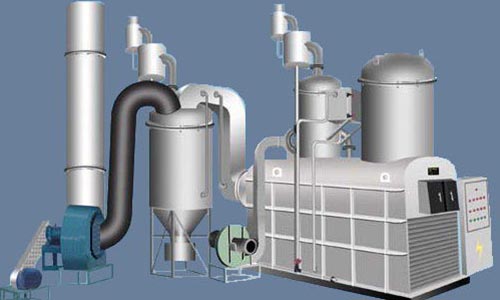Incinerator Lining Structure and Lining Refractories
Furnace hearth temperature is the first factor should be considered during selecting incinerator lining refractory. refractory materials and insulating materials should endure long term high incineration temperature. Secondly, combustion products corrosion to furnace lining must be considered. For example, when incinerating alkaline liquid waste, furnace temperature reaches to 1000℃, Na+ volatilizes in the form of sodium oxide vapor, SiO2 in refractory bricks reacts with Na2O and produces low melting point mineral(Na2O·Al2O3·2SiO2), which accumulates at the surface of refractory bricks and corrodes them. If high alumina brick is applied in the incinerator, Al2O3 reacts with Na2O and produces Na2O·Al2O3, which will make high alumina brick crack at high temperature, the mechanical strength is decreased. So high alumina refractories with high Al2O3 content, or chrome magnesia bricks, magnesia bricks, alumina magnesia bricks, which have better alkaline corrosion resistance can be adopted. To reduce permeation and corrosion caused by salts, alkali, slag and other media, low porosity refractory materials are usually adopted.
Different parts of incinerator has different temperature and corrosion condition, so corresponding refractory materials can be used to line working lining.
Vertical Liquid Waste Incinerator Refractory
The max temperature in combustion chamber is about 1400~1600℃, so corundum bricks contains at least 90% of Al2O3 can be adopted. The working temperature of upper furnace hearth is about 900~1000℃, high alumina bricks(Al2O3 >75%) can be used. The working temperature of middle furnace hearth is about 900℃, at this part, molten salt and alkali flows to lower part along furnace lining, the corrosion is severe, so first grade high alumina bricks can be used here. At lower part of furnace hearth, the working condition is basically the same as middle part, molten salts and alkali in the combustion products are prone to agglomerate at the slope and permeate into refractory material, if there is Na2CO3, the corrosion is severer. So the working condition of this part is worst than middle part, dense refractory with low porosity, such as fused refractory bricks should be adopted at this part.
The up mentioned refractory materials are only suitable for normal slat and alkaline corrosion. If the alkalinity is stronger, basic refractory materials such as magnesia refractory or chrome refractory should be adopted.
Rotary Incinerator Lining Structure and Refractory
Counter Current Rotary Furnace
For 1.9m diameter, 20m long rotary cylindrical furnace, furnace hearth temperature is between 950~1050℃, exhaust exit temperature is 320℃. The first 3m of the furnace shaft is casted with 200mm thick low calcium aluminate concrete, the rest 17m furnace shaft is brick-worked by 200mm thick first class 65#high alumina bricks. Furnace hood and furnace end are both round shields. Furnace hood is casted by 100mm thick lightweight refractory concrete, furnace end inner lining is casted with 50mm thick vermiculite-bauxite insulating layer, then 100m thick lightweight refractory concrete.
Cocurrent Rotary Furnace
For a cocurrent rotary furnace which has dimension of φ2.38*14m, the furnace chamber heat strength is 106.3*104KJ/m3·h(25.3*104kcal/m3·h), smoke evacuation temperature is 1000℃. The linings structure is: the permanent lining is casted by 2 layers of refractory concrete, with a thickness of 220mm, the insulating lining is casted by 110mm lightweight refractory concrete, the working lining is casted by phosphate refractory concrete. High temperature zone is lined by high alumina bricks.
Deodorization Furnace
For deodorization furnace, with φ2.5*5m dimension, the inner diameter is 2.1m, the combustion chamber diameter is 1.5m, the furnace hearth temperature is 900℃. The structure of the lining is: 2 layers of refractory concrete casted cylindrical body, 100mm thick lightweight refractory concrete casted middle layer, 100mm thick low calcium aluminate refractory concrete casted working lining. The conic node is 0.7m high, its inner lining is 150mm thick lightweight refractory concrete. The height of cone base is 1.74 m, its inner lining is the same as cylindrical body. The insulating layer of combustion chamber is 50mm thick vermiculate asbestos boards and the working lining is 114mm first grade high alumina bricks.

